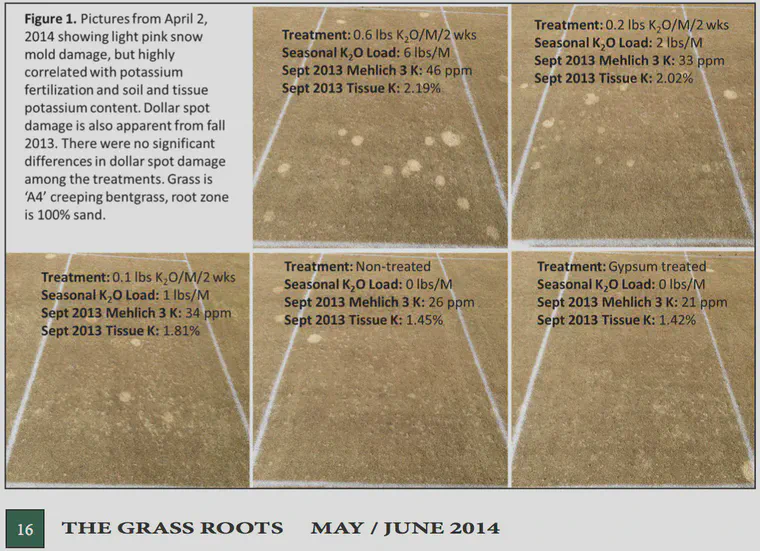Spots of excitement in a boring experiment
Doug Soldat reports on descreased pink snow mold associated with low soil potassium.
First he describes the study:
In 2011, we began a trial to attempt to identify the lowest level of soil potassium that would still provide high putting green quality. We also wanted to create severe potassium deficiences to document those symptoms for teaching purposes.
Treatments include 3 rates of potassium fertilizer, a control with no potassium, and a gypsum treatment with no potassium – adding gypsum will accelerate decreases in soil potassium. This is all on a sand rootzone with low cation exchange capacity. But those potassium deficiencies haven’t appeared yet:
Visually, this study has been about as boring as it gets. In three seasons, we have yet to observe any statistical differences in color, quality, or clippings.
In the spring of 2014, however, after the snow melted:
It was clear that the [pink] snow mold damage was influenced by the potassium treatments. Treatments receiving no potassium were essentially free of damage, and treatments receiving 0.2 – 0.6 lbs K2O/1000 ft2 biweekly [1 to 3 g K2O/m2/14 days] had roughly 10 infection centers per plot, covering about 3.5% of the turf.

Increasing rates of potassium fertilizer reduce the leaf calcium content. I measured this in creeping bentgrass grown in a rootzone with a high calcium content. Increasing rates of potassium fertilizer reduced soil and leaf tissue calcium and magnesium.
This happens with warm-season grass too. Grady Miller measured decreased calcium and magnesium in bermudagrass:
Increasing K fertilization resulted in a decrease in extractable Ca and Mg in both media with corresponding decreases in tissue Ca and Mg concentrations. High K rates appear to increase the potential for Ca and Mg deficiencies in bermudagrass, indicating that rates higher than those that provide sufficient K levels for normal growth should not be used.
The mechanism by which pink snow mold was increased or decreased on the potassium experiment at Wisconsin hasn’t been determined. Soldat suggests a possible reason for the potassium effect on disease, and gives some advice on how one might optimally manage potassium:
It is possible that the effect of potassium is to lower the calcium levels to a point where the plant becomes susceptible to fungal infection … These findings suggest that the optimum way to manage potassium on a sand root zone is to allow the soil potassium levels to drop near the … MLSN level of 35 ppm, then begin spoon feeding potassium in spring through summer, and stopping in August to allow the tissue levels to decrease and calcium levels to rise (which will happen naturally).